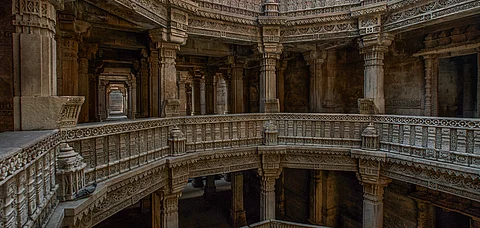
- Destinations
- Experiences
- Stay
- What's new
- Celebrating People
- Responsible Tourism
- CampaignsCampaigns
- SubscribeSubscribe
- Buy Now

An illustrious state with many feathers to its cap, Gujarat never ceases to amaze you. Be it the festive spirit of the state during the nine-day Navratri festival or the gorgeous architecture enveloping it or the mouthwatering delicacies that create taste riot in your mouth - Gujarat is an exquisite holiday spot that deserves a visit for more reasons than one.
A particularly exciting feature here is the step-wells - architectural marvels that stand as the glorious testimony to the bygone era. A water reservoir, essential to semi-arid regions, the construction of step-wells can be traced back to the Indus Valley Civilization, at the sites of Mohenjo-Daro and Dholavira. Catering to the water needs of the people of the nearby areas and even visitors, a stepwell usually has four to five storeys. The best artisans of the time were hired to beautify these step-wells, who carved on their walls, stories of the time and Sanskrit and Arabic inscriptions.
While these constructions may narrate a primordial story, the beauty of these structures remains timeless, making Gujarat an attractive visiting avenue, especially for history buffs and connoisseurs of design and architecture.
Pick out any city in Gujarat at random, and you will find a beautiful &lsquovav,&rsquo the local term for a stepwell in its restored form, some even preserved by UNESCO as World Heritage Sites. So come aboard a virtual road trip of sorts that takes you through the best step-wells in Gujarat in its different cities.
This journey of time travel will be magical and nostalgic - all at once. Read on
Dada Harir Vav, Ahmedabad
Around 500 years ago, in the quaint neighbourhood of Asarwa Village, Dada Harir Vav was built by Sultan Bai Harir. This step-well holds immense significance in the history of the area, as it provided water during long, dry seasons. Built in several storeys, beautiful picture carvings and texts in Sanskrit, as well as Arab script, adorn the walls. The best time to visit Dada Harir Vav is late morning when the light of the sunlight cascades on the walls revealing their beauty.
Adalaj Vav, Gandhinagar
Not just a water step-well, the Adalaj Vav in Gandhinagar was built in 1499 by Queen Rudabai, Vaghela Chief Veersinh&rsquos wife as a water reservoir and a spiritual refuge. People visited Adalaj to fill water and offer prayers to the carvings of deities on the walls. An interesting aspect of this octagonal well is that it only allows light to touch the flight of steps only briefly for some time in the noon, through the small opening in the ceiling, making the temperature six degrees cooler than what&rsquos on the outside. Designed in Indo-Islamic architecture, there are intricate floral designs on the walls beautifully merging with the Jain and Hindu symbolism. Particularly intriguing for visitors is the Kalp Vriksha carved out of a single slab of stone. Do notice the Navagraha at the edge of the well, which is known to protect the monument from evil spirits.
Rani Ka Vav, Patan
One of the finest step wells in India, Rani Ka Vav had found its place on the list of World Heritage Sites by UNESCO in 2014. Per historical anecdotes, Rani Ka Vav was built by Rani Udayamati in 1063 in the memory of her husband, King Bhimdev I. He belonged to the Solanki Dynasty. Flooded by the Saraswati River in the 1980s, the vav&rsquos carvings were found in unsullied conditions when the Archeological Survey of India excavated the site. With a total of seven galleries, one can see 800 sculptures with the central theme of the Dasavataras or the ten forms of Lord Vishnu. This place, along with being a utility, also holds spiritual significance.
Ramkund Stepwell, Bhuj
The Ramkund Stepwell in Bhuj is 56 feet deep and has beautiful wall carvings with portrayals from Ramayana including Lord Ram, Devi Sita, Lord Lakshman and Lord Hanuman. There are also incarnations of Lord Vishu in his ten forms on the walls of this well. This step-well is behind the Ram Dhun Temple, which also deserves a visit when you&rsquore here. The solitude of the area keeps you in its embrace, leaving you enough time to soak in the true beauty of this vav.
Adi-Kadi Vav and Navghan Kuwo, Junagadh
Inside Uparkot Fort in Junagadh lie two step-wells, Adi Kadi Vav and Navghan Kuwo. Very different from the usual step-wells built during the time these two are hewn out of a single rock. While Adi-Kadi Vav was built in the 15th century out of a hard rock, the Navghan Kuwo is about a thousand year old, partly belonging to soft rock construction and partly built like the usual step-wells. The Navghan Kuwo helped the fort survive long sieges, but the Adi-Kadi Vav has a stirring past. According to folktales, there was no water found in the vav after being carved, so a priest predicted the sacrifice of two unmarried girls to get water. The two were- Adi and Kadi. The more unpopular but plausible version of the story is that two royal women servants- Adi and Kadi fetched water from this step-well each day. In their memory, bangles and clothes have been hung at the nearby tree.
Helican Stepwell, Vadodara
Entering Gujarat&rsquos historical landscape in the 16th century, the spiralling staircase of the step-well makes it a different place to visit compared to all others in the state. The unusual design has attracted multiple visitors through the years, and the popularity is only soaring with passing time.
The more you learn and read about Gujarat, the more reasons you will have to visit the state. So get packing and experience this vibrant state in all its glory.
For more information on Navratri in Gujarat visit Gujarat Tourism.
For more information on Navratri packages visit Yatra.com
